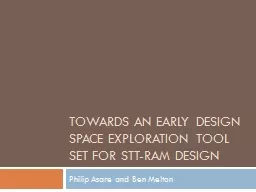

Set for STTRAM Design Philip Asare and Ben Melton STTRAM Overview Advantages Everything volatile currently has High speed SRAM Density DRAM AND Everything nonvolatile presents Nonvolatility ID: 379378
Download Presentation The PPT/PDF document "Towards An Early Design Space Exploratio..." is the property of its rightful owner. Permission is granted to download and print the materials on this web site for personal, non-commercial use only, and to display it on your personal computer provided you do not modify the materials and that you retain all copyright notices contained in the materials. By downloading content from our website, you accept the terms of this agreement.
Slide1
Towards An Early Design Space Exploration ToolSet for STT-RAM Design
Philip
Asare
and Ben MeltonSlide2
STT-RAM Overview: Advantages
Everything volatile currently has
High speed (SRAM)
Density (DRAM)AND Everything non-volatile presentsNon-volatilityLow Power (Flash)Reliability (Hard-drive)On its ownCMOS-compatibleGood scalability potential (over tradition MRAM)Potential for use as universal memory
2Slide3
STT-RAM Overview: Challenges
Device-Level
Tunneling Magneto-Resistance Ratio (TMR)
Fabrication IssuesCircuit-LevelCurrent-sensingVariation cell strength: reading difficultysense amp: offset (especially at smaller nodes)Stochastic nature of MTJArchitecture-LevelRead-write asymmetry in energy and delayPeriphery components may dominate
3Slide4
Road Map
STT-RAM Overview
Advantages
ChallengesRequirements for Addressing ChallengesOur Approach to Addressing ChallengesUnderstanding STT-RAMExperimental SetupResults + InsightsFuture Work + Summary4Slide5
Addressing STT-RAM Challenges
Requires cross-layer design
Layers of abstraction can get in the way
Need to know impact of decisions across layersNeed ‘generic’ way of doing thisTools available for cross-layer design (from SRAM)Technology Agnostic Simulation Environment (TASE)Process-to-Circuit-Level InterfaceOne simulation template different PTMsVirtual Prototyper (ViPro
)
Circuit-to-Architecture-Level Interface
Circuit-level decisions on Arch-level and vice versa
Can work on TASE output to provide full cross-layer view
Our Approach: Extend TASE +
ViPro
Concept for STT-RAM
5Slide6
Understanding STT-RAM: Structures
Storage Element*
MTJ Resistance Characteristics*
6
Bit Cell and Column
Array
* A. Nigam
et al., “Delivering on the Promise of
Universal Memory for Spin Torque Transfer RAM
(STT-RAM)” International Symposium on Low-Power Electronics and Design (ISLPED), August 2011Slide7
Understanding STT-RAM: Read
7
(1)
(2)
(1)
Decode address
select word
Turn on sense amp pre-charge BL
Disable
precharge
evaluate/read data
Turn off sense amp
(1)
(2)
(1)
X
X
X
(3)
(4)
(2)Slide8
Understanding STT-RAM: Write
8
(1)
(1)
Decode address
select word
Charge BL or SL to write (depends on value)
Disable write transistors
(1)
(2) or X
(2)
(3)
(3)
X or (2)
(2) or X
X or (2)Slide9
Experimental Setup
Independent Variables
Process Level: Technology PTM
Circuit-Level: VDD, W (of access transistor)Array-Level: Capacity, # Rows , Word sizeDependent VariablesEnergy: Read and Write (FOM)Delay: Read and Write (FOM)Associated intermediate variables (e.g. bit cell write time)
9Slide10
Experimental Setup
Experimental Workflow
Simulations
TASEFor each PTM, vary VDD+WCollect currents (read +write)HSPICECollect sense amp info (current, delay, Vread f(V))ViPro (Analytical Modeling and Virtual Prototyping)
use TASE output to calculate intermediate variables
compute FOMs based on analytical models
10Slide11
Results: Bit Cell Analysis
11
Setup
Iwrite-V CurveGeneral ResultsCurrent increases with voltageCurrent increases with node sizeSlide12
Results: Array-Level Decisions
12
Setup
Fixed Capacity (1MB)Fixed VDD=0.9V, W=22nm (22nmPTM)Varied #rows and word sizeGeneral ResultsE, D write > readD read ~ x1ns
D write ~ x10ns
E read, write < 1pJ
E, D more sensitive to
wordsizeSlide13
Results: Circuit-Level Decisions
13
Setup
Fixed array structureVary VDD and W (22nm PTM)General ResultsEnergy increases with VDDDelay decreases with increased VDDSlide14
Results: Circuit-Level Decisions
14
Setup
Fixed array capacityVary VDD and W (22nm PTM)General ResultsWidth has little effect on energySlide15
Results: Process-Level Decisions
15
Setup
Fixed array structureFix VDD=nominal for PTM, W=2WminVary PTMGeneral ResultsPTM has more effect on energyE,D increases with node size
*Note:
write delay artifact of modelSlide16
Insights
Majority of energy consumed in periphery
Decoders, Sense Amps
Cross-layer view better for optimizationDifficult to do without tools like TASE and ViProSTT-RAM modeling and design is still in its infancyFew good models availableAvailable models inconsistent from one to the otherThree distinct perspectives Process, circuit, and architecture with nothing in betweenTough to reconcile perspectives
16Slide17
Future Work + Summary
Future
Improve STT-RAM Models!!!
Requires more research and understandingWe made a lot of assumptionsExtend tools for more comprehensive analysisIntegrate tools better (minor implementation issue)We did a lot of manual ‘gluing’SummarySTT-RAM has the potential to shake the memory industryChallenges in design need to be overcome
Cross-layer design perspective required
We showed this can be done
17